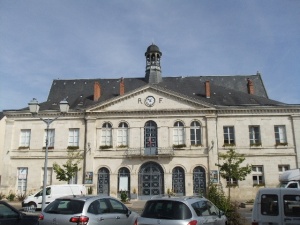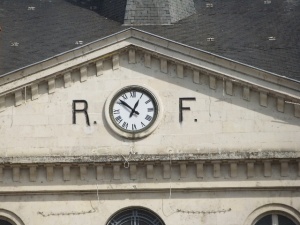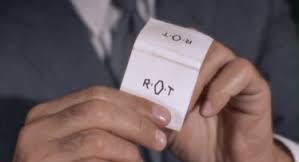Sitting on the terrace of the one and only Wifi café in this provincial little town, I once again look at the rather unimaginative architecture produced by The French Revolution – its Town Hall.
Quite typical, all over France these buildings look alike. Revolutions tend to standardise: people, buildings, thoughts, whatever…
I look up more closely and see this.
The R. and the F. stand for La République Francaise. You know – Brotherhood, Liberty, Equality and all that ideological jazz. The two capitals, however, are separated by a Clock, by Time itself. This is rather funny, as almost all revolutions have always wanted to finish with Time, with Time-as-History.
It suddenly strikes me. Could the spirit that took its hold on Hitchcock have already been floating over the waters, could it also have been the Revolutionary architect’s guardian angel!
In that evergreen of a movie – North by North-West – we encounter the uncanny couple of Eva Marie Saint and Cary Grant. We find them sitting together for a few uncomfortable moments.
She gets her cigarette fired and observes the little emblem that Cary has printed on the match covers which he hands out to the clients of his advertising firm. Carry is playing the man-on-the-run, Roger Thornhill.
“R O T”, Eve Mary Saint reads out loud, “What’s the ‘O’ standing for?” “Oh, for nothing. Just makes it more interesting…”
That must be the plot of this town hall’s Tympanum, that triangled cornice with the clock in between ‘R’ and ‘F’. Time as Nothingness – certainly after the Revolution.
So many deep philosophers have already said it: ‘Time does not exist’. It is merely an ‘attribute of matter’, thus Lawrence Durrell wrote in one of his wildfire letters to Henry Miller – ‘the idea of duration is false’.
This is the point where the would-be mystic and the would-be revolutionary meet. Both like to deny Death, after all that great guardian of human time. The would-be revolutionary, because he seems to exist in slaughter; the would-be mystic, because he fears death and even more so old age and getting decrepit.
Whereas the revolutionary elevates time into a supreme and revered Now, the mystic by contrast deflates the Here and Now, paying all his respects to the Before- and Afterlife. Yet ‘For ever young’, that’s what the two of them would like to be…
Out there on the café terrace I contemplated the clock’s two hands moving Time. Yes indeed, analogue time – time as expressed in movement through space. But oh so real! Not at all a ‘mere attribute of matter’.
Those who take only the Now for ‘real’ reduce reality to the mirage of a foolish mind. They forget that we actually live in a Now and in a Here. The present always involves a presence of things, of spaces – and of one’s own presence, the presence of mind which inevitably involves memory and longing.
Time without things is empty, things without time are oppressive. And what about music – Time so touchable, if even only slightly so…
I know it. Only so many turns of those hands equipped with their knife and fork, and I’m done with. Reminded by my disease, they will slowly consume what is left of my reality – and with it my past as well as my future.
Sierksma, Le Blanc 23.9/2016



